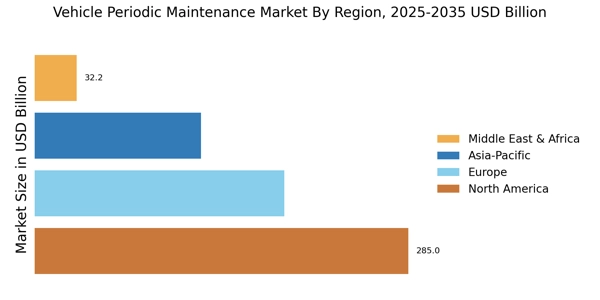Increasing Vehicle Ownership
The rise in vehicle ownership is a pivotal driver for the Vehicle Periodic Maintenance Market. As more individuals acquire vehicles, the demand for regular maintenance services escalates. In recent years, the number of registered vehicles has surged, with estimates indicating that there are over 1.4 billion vehicles on the roads. This growing vehicle population necessitates consistent maintenance to ensure safety and performance. Consequently, service providers are likely to expand their offerings to cater to this increasing demand. The Vehicle Periodic Maintenance Market is thus positioned to benefit from this trend, as vehicle owners seek reliable maintenance solutions to prolong the lifespan of their vehicles and enhance their operational efficiency.
Regulatory Compliance and Safety Standards
Regulatory compliance and safety standards are crucial drivers for the Vehicle Periodic Maintenance Market. Governments worldwide are implementing stringent regulations to ensure vehicle safety and environmental protection. These regulations often mandate regular inspections and maintenance, compelling vehicle owners to adhere to prescribed maintenance schedules. For example, in several regions, failure to comply with maintenance regulations can result in fines or penalties. This regulatory landscape creates a steady demand for maintenance services, as vehicle owners prioritize compliance to avoid legal repercussions. The Vehicle Periodic Maintenance Market is thus likely to experience sustained growth as adherence to safety standards becomes increasingly critical for vehicle operators.
Shift Towards Electric and Hybrid Vehicles
The shift towards electric and hybrid vehicles is emerging as a transformative driver for the Vehicle Periodic Maintenance Market. As the automotive landscape evolves, the maintenance needs of electric and hybrid vehicles differ from traditional combustion engine vehicles. This transition necessitates specialized maintenance services, including battery management and electric system diagnostics. Market projections indicate that the electric vehicle segment is expected to grow at a rate of over 20% annually, leading to an increased demand for tailored maintenance solutions. Consequently, the Vehicle Periodic Maintenance Market must adapt to these changes, offering services that cater specifically to the unique requirements of electric and hybrid vehicles, thereby capitalizing on this burgeoning market segment.
Rising Awareness of Vehicle Maintenance Importance
Rising awareness regarding the importance of vehicle maintenance is significantly influencing the Vehicle Periodic Maintenance Market. As consumers become more informed about the benefits of regular maintenance, such as improved fuel efficiency and enhanced safety, they are more inclined to invest in periodic services. Educational campaigns and information dissemination through various channels have contributed to this heightened awareness. Market data suggests that consumers who regularly maintain their vehicles can save up to 15% on fuel costs annually. This growing consciousness is likely to drive demand for maintenance services, as vehicle owners recognize the long-term advantages of proactive maintenance in preserving vehicle value and performance.
Technological Advancements in Maintenance Services
Technological advancements are transforming the Vehicle Periodic Maintenance Market, introducing innovative solutions that enhance service efficiency and customer experience. The integration of diagnostic tools, mobile applications, and telematics systems allows for more precise maintenance scheduling and tracking. For instance, predictive maintenance technologies can analyze vehicle data to forecast potential issues before they arise, thereby reducing downtime and repair costs. This trend is reflected in the increasing adoption of such technologies by service providers, which is expected to grow at a compound annual growth rate of over 10% in the coming years. As a result, the Vehicle Periodic Maintenance Market is likely to witness a shift towards more tech-driven service models.


















Leave a Comment